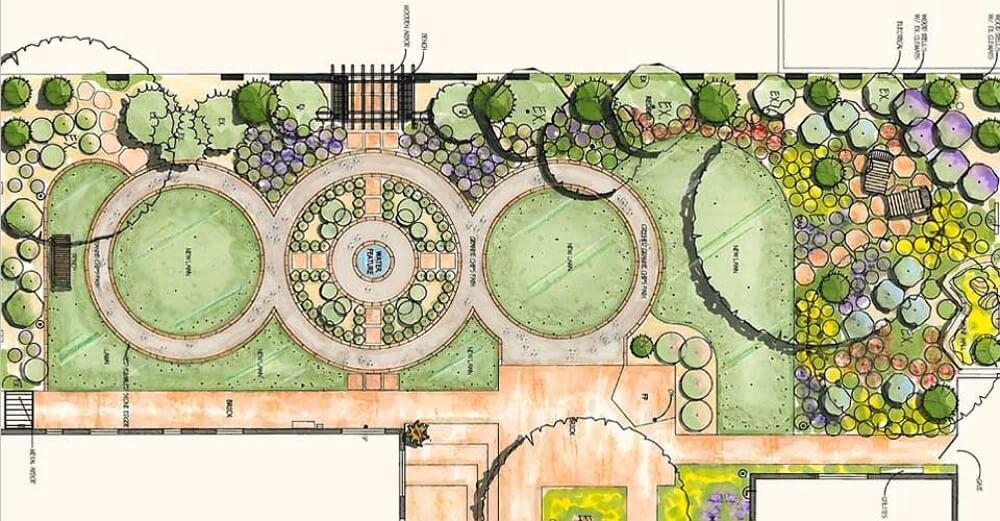The Basic Principles Of Landscapers
The Basic Principles Of Landscapers
Blog Article
The smart Trick of Landscapers That Nobody is Talking About
Table of ContentsLandscapers - An OverviewLittle Known Questions About Landscapers.Landscapers for DummiesOur Landscapers PDFsThe Of LandscapersLandscapers for Dummies
- A garden function where water is represented by an accumulated rock item, usually a crushed rock or granite.- A stone or natural flagstone patio area, course, or pathway constructed without a concrete base.- A rock preserving or cost-free standing wall surface built without making use of mortar. An extremely skilled mason is needed for a completely dry pile rock wall surface. Many walls in Rose city are moist piled, even if they show up to be. - An underground structure that collect water and permits it to reduce percolate right into the dirt around it.
Landscape design that is compatible with a websites' atmosphere in both appearance and sustainability without adverse effects to the atmosphere. Interrupting the landscape is a line of demarcation that produces visual interest in the yard by dividing one sector from one more sector. This can be visual or useful, maintaining one aspect (such as pea gravel) from getting combined into another (like bark dust).
Locations can also have a sensation of "room" supplied by trees, various other growings, fences, or displays. The landscape near the entrance to a structure.
Not known Facts About Landscapers
:max_bytes(150000):strip_icc()/GettyImages-154046398-c39f1daf45a84601b328d78ed8630660.jpg)
The element in a landscape layout or area in a landscape that is indicated to be most noticeable. The prime focus can be a plant, rock, sculpture, collecting area, or other landscape function. A design of yards or garden elements that worry straight lines, ideal angles and circles. Bushes or bushes situated in beds near the foundation of a home or various other structure.

Top Guidelines Of Landscapers
Rock item, either rounded or fractured, that is fairly small- typically 1" or much less. Reduced plants that are permitted or encouraged to spread over a location. Can refer to any type of "difficult" garden aspects consisting of statuary or rocks yet most frequently is used to refer to courses, patios, and walls.: Elevation difference between the degree of water in a pond (or the degree of the pump if it rests outside the pond) and the top electrical outlet of water which influences performance of the water pump in gph (gallons per hour). Thick hedges or trees that form a fence, screen, or border.
A chemical made use of to manage weeds. Fence boards that run flat, usually utilized in modern-day or Japanese-inspired landscape styles. Lines that define spaces within a landscape principle. These usually expand from edges or essential functions of an existing structure. Appropriate use of fictional lines can help the landscape really feel attached to the home and various other elements.
Conventional PNW landscapes are casual. A plant that spreads out more than desired, or into habitats where it does damage.
More About Landscapers
Smart irrigation controller evaluations and suggestions below. 2-D making of the proposed watering system. Can include head positionings and protection, pipeline sizing, GPM specifications, and materials required to mount this system. An irrigation plan is usually unnecessary for houses but prevails for commercial projects. Licensed specialist who designs landscapes, educated in design and style in addition to in horticulture.
The professional who plans and creates landscape jobs, normally at a domestic or small commercial level with the major style catalyst on plantings. Landscape designers normally have less schooling than Landscape Architects and are not licensed. A completed landscape style, detailing all aspects for the brand-new landscape. This generally takes the type of an illustration theoretically.
Utilizing several growings of the same click for more range to load in a location in the landscape. This can reduce maintenance and water use in the garden.
A layer of garden compost or bark dust applied at the base of a plant. A plant that was existing in a geographic location prior to people began transforming the landscape.
The Only Guide for Landscapers
Exactly how the yard or a yard aspect is prepared in relationship to an existing or new function or to an instructions. Grasses that are not trimmed yet expanded in landscapes as perennials.

Small round crushed rock. Plants that provide seasonal interest and then pass away back in the winter season. Annuals do not come back the complying with season, but perennials do. Winter lawn that is the most typical turf grass in Portland, OR and the rest of the PNW.An open roofed structure over a patio or other landscape attribute.
Lava accumulated ranging in size from 1/4" to dirt. The this link most common landscape gravel in the PNW. Area of the landscape made to handle water until it can saturate right into the ground. A chain that regulates water as it takes a trip from a roof rain gutter to the his response ground. Yard structure that produces a growing area that is had and greater than the bordering quality.
Framework made of timber, concrete, leading rocks, blocks or various other products for stabilizing inclines and stopping too much disintegration. Slim gutter. Producing a yard feature consisting mostly of rocks with growings that match and can flourish in the rough atmosphere. Sprinkler head design that turns a stream of water across an area.
An Unbiased View of Landscapers
:max_bytes(150000):strip_icc()/look-up-look-down-photography--o7ASOHDV9E-unsplash-62ac6efd6d724c7abb7320fefe03b411.jpg)
Report this page